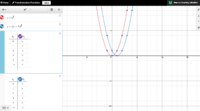Transformation Functions
- Thread starter yalialp06
- Start date
Steven G
Elite Member
- Joined
- Dec 30, 2014
- Messages
- 14,591
Suppose you want the y-values for both equations to be 0, 1, 4, and 25. What x-values will you use for y=x^2 and what x-values will you use for y=(x-1)^2? How do the x-values from the two functions compare to one another? Possible graphing those points will also help.
Please post back with your thoughts.
Please post back with your thoughts.
Suppose you want the y-values for both equations to be 0, 1, 4, and 25. What x-values will you use for y=x^2 and what x-values will you use for y=(x-1)^2? How do the x-values from the two functions compare to one another? Possible graphing those points will also help.
Please post back with your thoughts.
I notice that the x values have to be greater in the second function in order to end up with the same y values that I had in the first function. If the x values are greater than those in the previous function then the graph must shift right. I'm still trying to make sense of it though.
I just was thinking that it has something to do with the y values changing, not the x values. For example, the y values are smaller in the second function because I am squaring a smaller x value. How is this idea connected to what I noticed in the preview paragraph.
Steven G
Elite Member
- Joined
- Dec 30, 2014
- Messages
- 14,591
This type of shift has nothing to do with the change in the y-value.I just was thinking that it has something to do with the y values changing, not the x values. For example, the y values are smaller in the second function because I am squaring a smaller x value. How is this idea connected to what I noticed in the preview paragraph.
Looking at these points, I do see that the first point shifted one place to the right because the x value increased by one. I just don't see how subtracting one from x in the actual function leads to shifting the parent function to the right.If one function has the point (3, 7) and a 2nd function has the point (4, 8) isn't the 2nd point shifted one place to the right?
I also see that since you take away 1 from x, the x values have to be greater in order to yield the same y values as in the parent function. I think that to compensate for taking 1 away from x in the second function y=(x-1)^2, I must increase the x values by 1, therefore, shifting the function right. Is that right? And yet, I still don't see it visually on the graph, the minus 1 resulting in a positive horizontal shift.
Steven G
Elite Member
- Joined
- Dec 30, 2014
- Messages
- 14,591
When I square 5 I get 25.
We are going to play a game. You need to give me a number knowing that I will square the number and want to get 25. One more rule, before squaring the number you give me I will subtract one from that number first. What number(s) will you give me?
We are going to play a game. You need to give me a number knowing that I will square the number and want to get 25. One more rule, before squaring the number you give me I will subtract one from that number first. What number(s) will you give me?

